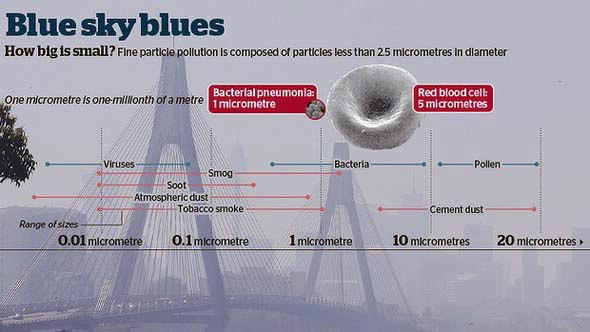ANSTO is using novel and evolving nuclear techniques to identify the underlying contributors to fine particle air pollution.
 |
| Nuclear techniques used at ANSTO are helping to fingerprint the sources of fine particle air pollution In Sydney, as well as other major cities around the world. Image courtesy of Fairfax. |
Check out some of our live data monitoring feeds from key sites along the New South Wales (Australia) coast.
While Australia’s air quality is generally excellent, the techniques can identify pollution sources so it can be further improved, and have significant applications in developing or industrialising countries.
Using nuclear instruments such as positive ion accelerators and data collection, scientists can now determine elemental air pollution fingerprints, quantifying sources and origin with great accuracy.
This method is, right now, being used in Australia and overseas to identify impacts of fine particle pollution on health, visibility and long range transport of pollutants.
In Asia it has been used to track the fingerprints of factories that contribute to air quality issues, and even in Australia, it has been used for many years to identify fine particle pollution sources.
Professor David Cohen, Chief Research Scientist, Institute for Environmental Research at ANSTO, explains the purpose of the fingerprinting is not finger-pointing, but to help improve air quality.
“Even for relatively low-pollution countries such as Australia, atmospheric fine particle pollution can impact on human health, which is why we measure and track sources,” said Professor Cohen.
“If you can identify sources of pollution as well as quantify their contributions to the total pollution load, you can better understand how to reduce the impact of said pollutants, and that’s an important milestone for science.
“There has been strong progress over the last decade to identify sources and tackle polluters, and our research is about enabling practical, tangible steps towards assisting air pollution managers to continue to improve air quality.
“By world standards, we have good air quality in Sydney which has been consistently improving over many years, and research like this will help us to further enhance it.”
Over the past decade, studies of fine particle pollution have moved from just chemical characterisation to using statistical techniques and models to fingerprint the source of pollution.
Coal-fired power stations are known emitters of fine particles and pollutant gases, and ANSTO techniques have determined contributions of eight coal-fired power stations in NSW to the total pollution load in the greater Sydney metropolitan area where over four million people live and work.
The data obtained through use of these nuclear techniques can also be used to correlate high pollution days, with sources of air pollution.
Professor Cohen’s latest peer reviewed research, Accelerators provide fingerprints of coal-fired power stations’ air pollution in metropolitan Sydney, is available here.
The science of monitoring air pollution
Fine particle samples are collected on thin stretched Teflon filters and analysed using Ion Beam Analysis, which is a fast, sensitive and non-destructive way of establishing chemical concentrations within the filter.
The filters are characterised by their weight and elemental composition. More than 20 different elements - including carbon, silicon, iron, sulphur and lead can be identified.
The following animation illustrates the process.


